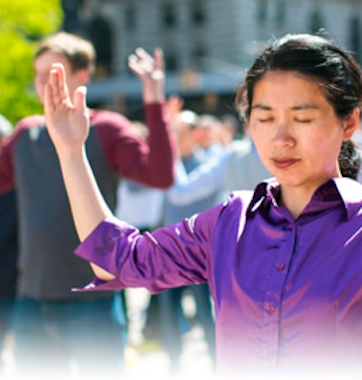Greg Brown had just exited the City County Building in downtown Knoxville Tuesday morning when he happened upon a scene close to his heart.
A 12-year military veteran and recipient of four gunshot wounds while fighting [party' name omitted] insurgencies in Cambodia, Brown had been visiting Sen. Fred Thompson's office to petition for disability compensation when he encountered a group practicing Falun Gong.
The group is traveling from Houston to Washington to promote awareness of the Chinese government's mistreatment of people who practice Falun Gong -- an art that has gained international attention lately as it surged to become one of the most popular pastimes in China.
Not a religion, sect or, as some suggest, a cult, Falun Gong is more like Tai Chi or meditation in motion -- an act meant to cleanse the mind, body and spirit.
Introduced by Li Hongzhi in May 1992, Falun Gong has skyrocketed in popularity to now includes an estimated 100 million practitioners in more than 40 countries.
It has not done so, however, without heavy interference from the Chinese government.
"This challenges the evil nature of the [party' name omitted] government," said Hongyi Pan, a demonstration participant said. "It's a conflict between evil and righteousness."
As the six people performed Falun Gong exercises to traditional Chinese music, Brown scanned over scores of pictures affixed to a makeshift wall.
The pictures depicted devastating bruises, abrasions, lacerations as well as burn and electric shock wounds on dozens of Chinese people detained for practicing Falun Gong.
"This is what I was fighting for," Brown said. "To stop stuff like this from happening. This is atrocious."
Before Brown arrived, [...] Amy Lee spoke to the sparse crowd about her experiences protesting the Chinese government's treatment of Falun Gong practitioners.
The 33-year-old began practicing while her father was recovering from a brain injury. After performing Falun Gong for a few years, Lee went to Beijing in 1999 to protest the government crackdown on the group.
"Instead of meeting government officials, I was arrested, striped naked and beaten until I lost consciousness," she said through a translator.
A few weeks later Lee was sent back to her hometown of Guangzhou and forced to work in a labor camp making decorative lighting fixtures and toys for fast-food restaurants' children's meals.
An extraordinary artist who has recently found work in New York City as a fashion designer, Lee displayed museum-quality pencil sketches oozing with the grim details of life inside a Chinese prison.
Next to the sketches was a picture of her infant daughter who Lee has not seen since she was forced to divorce her husband and flee Guangzhou.
Desperate and evading further arrest, Lee found a Western journalist who helped secure her arrival in America.
"It's like a nightmare," Lee said. "In the blink of an eye, I lost everything."
All content published on this website is copyrighted by Minghui.org. Non-commercial reproduction must include attribution (e.g. "As reported by Minghui.org, ...") and a link to the original article. For commercial use, contact our editorial department for permission.
Category: Falun Dafa in the Media










